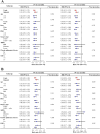Early acetaminophen administration is associated with lower mortality among ARDS patients after coronary artery bypass grafting: a retrospective study
- PMID: 40251639
- PMCID: PMC12007132
- DOI: 10.1186/s13019-025-03421-x
Early acetaminophen administration is associated with lower mortality among ARDS patients after coronary artery bypass grafting: a retrospective study
Abstract
Background: Acetaminophen (APAP) is widely used in the treatment of patients after surgery, but the prognosis of patients with coronary artery bypass grafting (CABG)-related acute respiratory distress syndrome (CABG-ARDS) is still unclear. This study aims to explore the role of APAP in the management of CABG related ARDS.
Methods: We collected clinical data on patients with CABG-ARDS from the Medical Information Mart for Intensive Care-IV (MIMIC-IV) database. The primary outcome was early mortality after ARDS, and the secondary outcomes were length of hospital stay and duration of mechanical ventilation (MV). Multivariate logistic regression and Cox regression models were used for statistical analysis, and inverse probability processing weighting (IPTW), overlap weighting (OW) and propensity score matching (PSM) were used to explore the robustness of the outcomes.
Results: A total of 5459 patients were enrolled in the analysis. Multivariate logistic regression analysis revealed that the 14-day mortality in APAP group was significantly lower than that in non-APAP group (0.5% vs. 2.7%, OR = 0.301; 95% CI, 0.170-0.531; P < 0.001). The APAP group also showed a significant advantage in Cox regression analysis (0.5% vs. 2.7%, HR = 0.329; 95% CI, 0.187-0.577; P < 0.001). IPTW, OW, and PSM analyses were conducted between the two groups, and the differences remained significant. These results were consistent in 30-, 60-, and 90-day mortality analyses. Meanwhile, exposure to APAP was associated with a shorter length of hospital stay and a reduced duration of MV (P < 0.001).
Conclusion: The administration of APAP was associated with reduced early mortality in patients with CABG-ARDS, as well as shorter length of hospital stay and duration of MV.
Keywords: Acetaminophen; Acute respiratory distress syndrome; Coronary artery bypass grafting; MIMIC-IV; Mortality.
© 2025. The Author(s).
Conflict of interest statement
Declarations. Ethics approval and consent to participate: The study protocol adhered the ethical guidelines of the Declaration of Helsinki. MIMIC-IV is an anonymized public database. The project was approved by the institutional review boards of the Massachusetts Institute of Technology and Beth Israel Deaconess Medical Center. As all personal data in the database are de-identified, informed consent was waived. Competing interests: The authors declare no competing interests.
Figures





Similar articles
-
Effects of acetaminophen use on mortality of patients with acute respiratory distress syndrome: secondary data mining based on the MIMIC-IV database.BMC Pulm Med. 2024 Nov 14;24(1):568. doi: 10.1186/s12890-024-03379-x. BMC Pulm Med. 2024. PMID: 39543557 Free PMC article.
-
Association between pre-ICU aspirin administration and ARDS mortality in the MIMIC-IV database: A cohort study.Pulm Pharmacol Ther. 2024 Jun;85:102288. doi: 10.1016/j.pupt.2024.102288. Epub 2024 Mar 8. Pulm Pharmacol Ther. 2024. PMID: 38460725
-
Enhanced recovery after surgery program for patients undergoing isolated elective coronary artery bypass surgery improves postoperative outcomes.J Thorac Cardiovasc Surg. 2024 Aug;168(2):597-607.e2. doi: 10.1016/j.jtcvs.2023.08.019. Epub 2023 Aug 21. J Thorac Cardiovasc Surg. 2024. PMID: 37611846
-
Stroke Rates Following Surgical Versus Percutaneous Coronary Revascularization.J Am Coll Cardiol. 2018 Jul 24;72(4):386-398. doi: 10.1016/j.jacc.2018.04.071. J Am Coll Cardiol. 2018. PMID: 30025574
-
Prior Percutaneous Coronary Intervention and Mortality in Patients Undergoing Surgical Myocardial Revascularization: Results From the E-CABG (European Multicenter Study on Coronary Artery Bypass Grafting) With a Systematic Review and Meta-Analysis.Circ Cardiovasc Interv. 2018 Feb;11(2):e005650. doi: 10.1161/CIRCINTERVENTIONS.117.005650. Circ Cardiovasc Interv. 2018. PMID: 29440275
References
-
- Stephens RS, Shah AS, Whitman GJR. Lung injury and acute respiratory distress syndrome after cardiac surgery. Ann Thorac Surg. 2013;95:1122–9. - PubMed
-
- Gorman EA, O’Kane CM, McAuley DF. Acute respiratory distress syndrome in adults: diagnosis, outcomes, long-term sequelae, and management. Lancet. 2022;400:1157–70. - PubMed
-
- Bos LDJ, Ware LB. Acute respiratory distress syndrome: causes, pathophysiology, and phenotypes. Lancet. 2022;400:1145–56. - PubMed
-
- Ware LB, Matthay MA. The acute respiratory distress syndrome. N Engl J Med. 2000;342:1334–49. - PubMed
-
- Kaku S, Nguyen CD, Htet NN, Tutera D, Barr J, Paintal HS, et al. Acute respiratory distress syndrome: etiology, pathogenesis, and summary on management. J Intensive Care Med. 2020;35:723–37. - PubMed
MeSH terms
Substances
LinkOut - more resources
Full Text Sources
Medical
Miscellaneous

